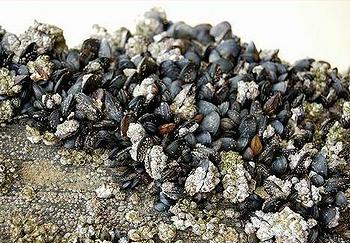
WAGENINGEN, The Netherlands, September 26, 2012 (ENS) – Plastic nanoparticles released when plastic debris decomposes in seawater can have an adverse effect on sea animals, Dutch scientists have found.
Nanoparticles of plastic measuring just thirty millionths of a millimeter, invisible to the naked eye, are responsible for inhibiting feeding and growth in mussels, according to new research by Professor Bart Koelmans of Wageningen University and his research team.
They published a report of their investigations in the most recent issue of the journal “Environmental Toxicology and Chemistry.”
“The presence of plastic soup in the oceans is regarded as a big problem,” says Koelmans, a professor of water and sediment quality who is associated with IMARES, the Institute for Marine Resources and Ecosystem Studies, at Wageningen University.

The plastic soup is formed when plastic debris decomposes in seawater. “Such particles are probably also released from cosmetics and from clothes in the wash, subsequently entering the sewage system and surface waters and eventually reaching the sea,” Koelmans explains.
Koelmans and his team exposed mussels to various concentrations of nanoplastic in order to discover the concentration at which an effect was noticeable.
They found that the exposed mussels eat less of their normal food, algae, than mussels that have not been exposed to plastic nanoparticles, and they grow less well.
By giving the plastic nanoparticles color, and by measuring them using dynamic light scattering, it was possible to determine the particle concentration that exerted an effect on the test mussels.
The researchers write that the extent to which the tiny plastic particles clump together is extremely important for understanding particle uptake and the resulting effects in marine organisms.
“It means that those effects are not easy to predict because the biological availability of the particles can differ enormously from one organism to another, and because variation in water quality also plays a role,” says Koelmans.
Very little is known about the effects plastic nanoparticles have on sea life. The effects revealed by this study do not yet prove that plastic in the North Sea is a big problem, but they do suggest that further research is extremely important, Koelmans said.
This study is the first of four by Wageningen University and IMARES that will investigate the effects of plastic in the North Sea.
The next will focus on the effect of plastic on lugworms, which lose weight due to uptake of plastic particles. The scientists have already found that as a result of their exposure to nanoplastics the worms take in more toxic substances such as polychlorinated biphenyls (PCBs), which bind to plastics, than worms that have not been exposed.
Koelmans sees the need for research into other toxic substances that bind to plastic in seawater.
In order to analyse the interaction of plastic and other toxic substances in the food web, Koelmans’ group has created a detailed computer model to estimate the risks posed by plastics in the sea.
The final study in this series investigates the effects of plastic debris in the stomachs of fish. The analysis of hundreds of fish shows that 12 percent of them have debris in their stomachs and roughly half of that debris is plastic.
Koelmans says the European Union and the Dutch government recognize the problem and the need to monitor the existence of plastics in the seas in order to learn more about present and future concentrations of plastic micro-particles and nanoparticles in marine environments.
Copyright Environment News Service (ENS) 2012. All rights reserved.
